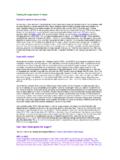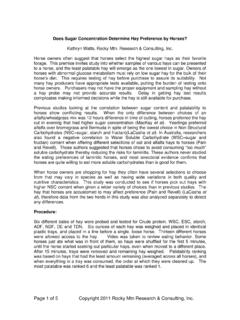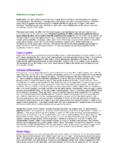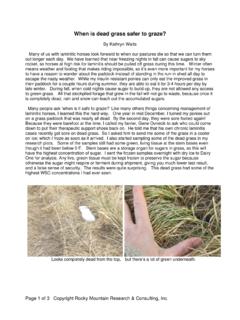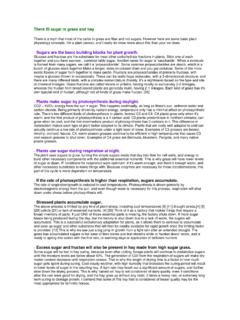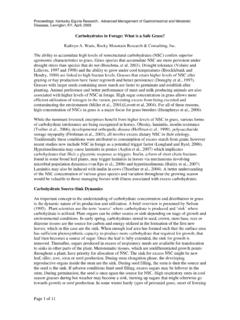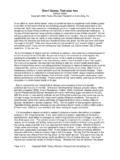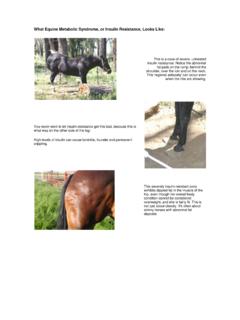Transcription of Carb content labels on horse feeds - Safergrass.org
1 Guarantees on low carb horse feed labels Press release from The owner of LMF feeds , Marlin Statema, had a dilemma. In 2004, his equine nutritionist, Dr. Stephen Duren and Kathryn Watts of teamed up to make horse feeds that were testing lower in sugar, starch and fructan than competing low carb products, but he was not allowed to prove that by guaranteeing the amounts on the product labels . What is required and allowed on an animal feed label is regulated by individual states. feed manufacturers must follow specific formats for feed labels , set by each states regulatory agency. Anything guaranteed must be defined and testable. Listing the amount of sugar, starch or fructan (collectively known as Non Structural Carbohydrates NSC) is not part of that standard, and therefore was not allowed on any feed label in any state of the USA. Those nutrients listed on the label are subject to testing by feed officials who randomly probe and analyze feeds in stores to assure the consumer that levels conform to guarantees stated on the label .
2 Since there is no standardization in the definitions and analytical procedures for sugar, starch and fructan, enforcement of guarantees on feed labels is difficult. Regulatory officials, feed company representatives and other industry experts network in an advisory group called Association of American feed Control Officials. AAFCO suggests standards that each individual state may choose to follow in an effort to gain uniformity in feed regulations and labeling requirements that are essential to interstate commerce. LMF contacted Oregon feed regulatory official Richard Ten Eyck who was forward thinking enough to lead the way by adopting an interim policy in June, 2005 that allowed NSC to be listed on horse feed labels in Oregon and defined terms as to what Low NSC actually was with a guaranteed percentage of <11% NSC. Industry and consumer requests initiated the formation of a committee within AAFCO in 2005, headed first by Steve Traylor of the National Grain and feed Assn.
3 And later by Mr. Ten Eyck, to discuss and propose a label format guaranteeing NSC levels in horse feeds that could be voluntarily adopted by individual states. The first order of business was to agree on terminology to be used. While this might seem a simple task, it ended up being quite complicated because everyone has a different definition for sugar, starch and fructan; even for NSC. Should we define what low is? That is difficult, as we lack properly conducted scientific studies on the nutritional relevancy of various fractions in NSC in horses . Some members wanted to postpone the label requirement until new, more precise analytical methods were developed. Others said that we could not proceed until proper studies were conducted in horses to prove what levels were detrimental or beneficial. Others worried about litigation if claims were made or inferred that a bagged feed could cure a medical condition such as laminitis or hyperinsulinemia.
4 Some argued it would do no good to guarantee NSC levels in bagged feed because they had no control over NSC of pasture or hay, which is the major portion of a horse s diet. Kathryn Watts research into NSC content of grass, supported by the Animal Health Foundation, started the whole process by using what she learned to find the low NSC grass to make the first generation LMF low carb horse feeds . She ended back in the fray when she was invited to join the AAFCO Carb label work group in late winter of 2009 as the only representative for horse owners. She provided as yet unpublished studies conducted with equine researchers that showed how NSC effect horses , and fought to push this labeling initiative through as soon as possible, stating that imprecise information such as WSC or ESC is better than no information at all . She championed informed owners of carbohydrate intolerant horses , who already test their hay for NSC and minimize access to fresh grass when conditions cause high NSC levels.
5 She told the other committee members As the science has been lacking all this time, we horse owners have already accepted personal responsibility for determining what levels of NSC our individual horses can handle. Just give us the numbers so we can make our own informed decisions . After 5 years of deliberation and 23 revisions of the proposed wording, the Carb committee s came to a consensus and their recommendation was accepted by the AAFCO Labeling committee and sent to the board to start the process of implementation as a model rule. The proposed label requirement is as follows: (1) A commercial feed which bears on its labeling a claim in any manner for levels of dietary starch , sugars, fructans, or words of similar designation, shall include on the label : (a) Guarantees for maximum percentage of dietary starch and maximum percentage sugars, in the Guaranteed Analysis section immediately following the Crude Fiber guarantee. (b) A maximum percentage guarantee for fructans immediately following sugars, if the feed contains forage products.
6 (c) Feeding directions shall indicate the proper use of the feed product and a recommendation to consult with a veterinarian or nutritionist for a recommended diet. The required terms starch, sugar and fructan have been established, and new analytical procedures are being developed and standardized by USDA-Agricultural Research Service to test for them. Individual states may choose to wait until AOAC approved methods are in place, or they may define and utilize existing laboratory methods as they see fit. Under Ten Eyck s leadership, Oregon feed regulators are using Equi-analytical Laboratory of Ithaca, NY and defining sugar as Ethanol Soluble Carbs (ESC) and fructan as Water Soluble Carbs (WSC) -ESC. Implementation of this proposal will be consumer driven. Now is the time for horse owners who want to know the sugar, starch and fructan levels of feeds being marketed as low carb to contact their states feed regulators. These will be a found through each states department of agriculture, office of animal feed regulation.
7 Consumers should contact their horse feed company and ask that they join in convincing state feed regulators that we need this information on our low carb horse feed labels . If the consumers make their needs be known, we might begin to see some guaranteed amounts of NSC on horse feed labels to back up claims about carbohydrate levels. If implemented widely, this label regulation could have a huge impact on the prevention and management of horses with laminitis and other conditions that require controlled levels of NSC in the diet. I thank the Animal Health Foundation for their support, and all other supporters for their donations that allowed me to spend the time on this and other projects that will help owners of horses with laminitis. Now make your needs be known! Sincerely, Katy Watts Here s a sample email for your state feed regulator: Keep it simple and brief and they might actually read it. Dear < State feed Regulatory official>, I need to know how much sugar, starch and fructan are in my horses feed .
8 Some feeds being marketed as low carb are really not low enough for my horse . I need to see guaranteed numbers on the feed tag. Please consider the proposed ruling recently sent to the AAFCO Labeling committee with the following wording: (1) A commercial feed which bears on its labeling a claim in any manner for levels of dietary starch , sugars, fructans, or words of similar designation, shall include on the label : (a) Guarantees for maximum percentage of dietary starch and maximum percentage sugars, in the Guaranteed Analysis section immediately following the Crude Fiber guarantee. (b) A maximum percentage guarantee for fructans immediately following sugars, if the feed contains forage products. (c) Feeding directions shall indicate the proper use of the feed product and a recommendation to consult with a veterinarian or nutritionist for a recommended diet. The sugar can be defined as ESC. Fructan as WSC-ESC. All these tests for guaranteed levels on feed tags may be done at As a taxpayer in <state> I would very much appreciate your action to enact this as a rule ASAP.
9 If you find out the contact information in your state, please contact me at so I can add to this list. State Name Email phone CO Laurel Hamling MO Tony L. CA Kent Kitade 916-445-2140 WA staff 360-902-2025 OH 728-6410 GA Julie Hester RI Kenneth Ayars 222-2781 NC Daniel L. Ragan 919-733-7366 AZ Jack Carol Warren Bontoyan 410-841-2721OR Richard Ten Eyck 503-986-4691
